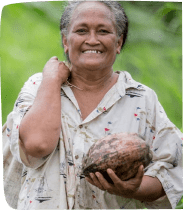They’re all improving lives in Papua New Guinea!
Papua New Guinea (PNG) is the largest country in the Pacific, with a population of 7.5 million people. 80% of the population live in rural areas – most of which rely on farming their land for food with little opportunity to sell what they reap in order to pay for things like improved housing, school fees, and making investments into their farming businesses.
Oxfam’s HARVEST project kicked off in PNG last March with the goal of assisting 2000 families to improve their food security and livelihoods.
There have been many successes and many challenges, but thanks to your support, we were able to roll out four very innovative ideas during year one.

Kelly Inae, owner of Mountain Honey, helps provide support for beekeepers alongside Oxfam. Photo: David Shields/Oxfam NZ
An onion dryer.
Bulb onions are a huge source of income for many families, but they need to be dried in order for them to last long enough to sell at lucrative markets in the cities. Farmers in PNG began using wood fires to do this, but after a while decided to trial an all-solar dryer in order to reduce the amount of trees they were chopping down. The all-solar dryer wasn’t completely successful either, as there were too many cloudy days to dry the onions sufficiently. To compromise, Oxfam and partners have rolled out a trial of a hybrid dryer that utilises solar power where possible, but is backed up by a wood burner on overcast days. To offset the continued use of wood, Oxfam are working with partners on natural resource management and reforestation, with a focus on re-planting native trees. Should the results of the hybrid dryer trial be successful, learnings will be passed around onion farmers all over PNG.
A hotline for beekeepers.
Being so far out from the cities, rural farmers can often struggle to get advice on issues that affect their livelihoods. Thanks to your support, even the most remote beekeepers can access instant support with the ‘honey hotline’. Beekeepers can call the hotline right from their village and get advice from experts on everything from caring for bees and managing hives, to monitoring honey production and extracting it to sell. With support as effective as this, farmers can successfully maintain thriving beehives and thriving livelihoods.
A mobile banking service.
Banking in PNG can be incredibly difficult and sometimes dangerous, particularly for women. People may have to travel many kilometres on treacherous roads from rural areas to reach a bank, which can cost them valuable time. Not only are we supporting women to be involved in their family’s finances, but we’re supporting three local community groups to participate as rural mobile banking agents. This enables farmers, both women and men, to bank using their mobile phone right from their village – a much safer and more efficient option.
“Before, we never had bank accounts and had to hide our money or spend it. If we did have a bank account it took all day to travel to town to deposit or withdraw money. It would be expensive to travel and it was not safe. Being able to deposit and withdraw money in our village, people are able to comfortably and safely access their bank accounts. This means they will save more, and more money will be spent at trade stores in our community rather than in town. This will increase our village economy.” – Toppy Sundu.

Photo: John Paul Sundu.
A beekeeping newsletter.
PNG’s domestic honey demand is very high, making beekeeping a viable livelihoods option for people. It’s not as familiar to farmers as growing vegetables, but selling honey has potentially greater rewards. We’ve rolled out the ‘PNG Bee Buzz’ which is published every quarter. Much like a community newsletter, it includes stories and advice on how to deal with common beekeeping issues, where to ask for support and where to get equipment, as well as generating public awareness of beekeeping as a great way to make a living.
The HARVEST Project is supported by Oxfam New Zealand and the New Zealand Aid Programme.













